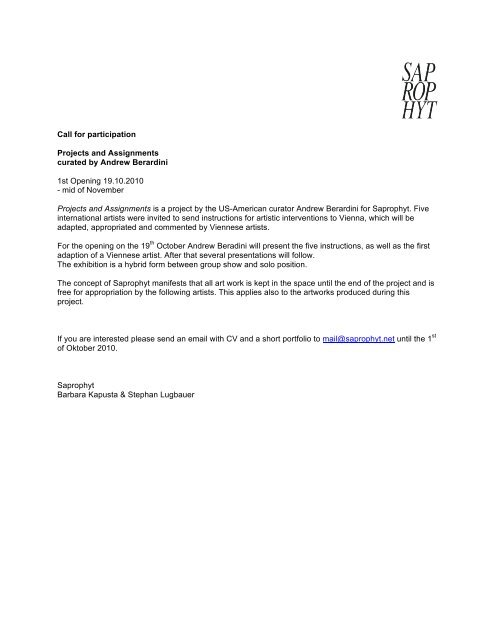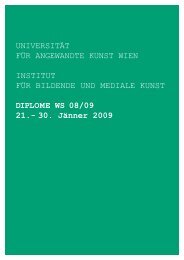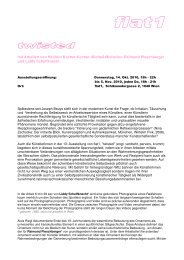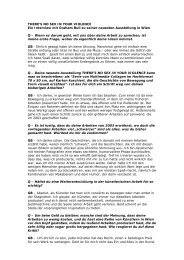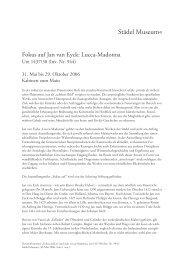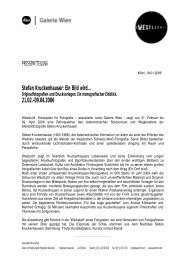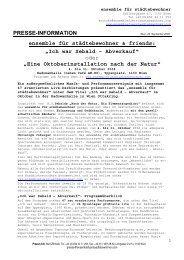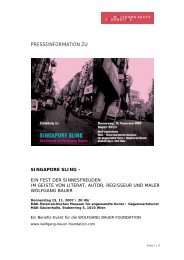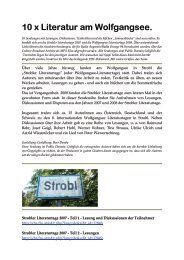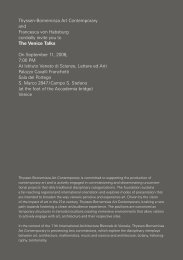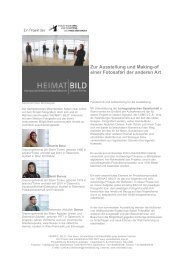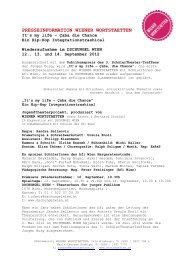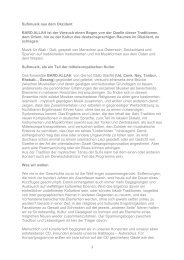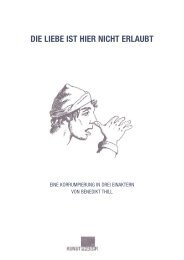Call for participation Projects and Assignments curated by Andrew ...
Call for participation Projects and Assignments curated by Andrew ...
Call for participation Projects and Assignments curated by Andrew ...
You also want an ePaper? Increase the reach of your titles
YUMPU automatically turns print PDFs into web optimized ePapers that Google loves.
<strong>Call</strong> <strong>for</strong> <strong>participation</strong><br />
<strong>Projects</strong> <strong>and</strong> <strong>Assignments</strong><br />
<strong>curated</strong> <strong>by</strong> <strong>Andrew</strong> Berardini<br />
1st Opening 19.10.2010<br />
- mid of November<br />
<strong>Projects</strong> <strong>and</strong> <strong>Assignments</strong> is a project <strong>by</strong> the US-American curator <strong>Andrew</strong> Berardini <strong>for</strong> Saprophyt. Five<br />
international artists were invited to send instructions <strong>for</strong> artistic interventions to Vienna, which will be<br />
adapted, appropriated <strong>and</strong> commented <strong>by</strong> Viennese artists.<br />
For the opening on the 19 th October <strong>Andrew</strong> Beradini will present the five instructions, as well as the first<br />
adaption of a Viennese artist. After that several presentations will follow.<br />
The exhibition is a hybrid <strong>for</strong>m between group show <strong>and</strong> solo position.<br />
The concept of Saprophyt manifests that all art work is kept in the space until the end of the project <strong>and</strong> is<br />
free <strong>for</strong> appropriation <strong>by</strong> the following artists. This applies also to the artworks produced during this<br />
project.<br />
If you are interested please send an email with CV <strong>and</strong> a short portfolio to mail@saprophyt.net until the 1 st<br />
of Oktober 2010.<br />
Saprophyt<br />
Barbara Kapusta & Stephan Lugbauer
Upcoming<br />
19.10.2010<br />
<strong>Projects</strong> <strong>and</strong> <strong>Assignments</strong><br />
<strong>curated</strong> <strong>by</strong> <strong>Andrew</strong> Berardini<br />
The trick is to create something physical <strong>and</strong> trans<strong>for</strong>mative with an economy of means.<br />
Something that denies the pure dematerialization of the internet, but as graceful a gesture as an athlete’s subtle turn<br />
or a beautiful woman opening a window.<br />
Two of the artists come from that slightly more idealistic moment popularly known as the 1960s. The others come<br />
from the present moment.<br />
David Askevold’s <strong>Projects</strong> Class came as the immediate inspiration. Canadian artist Askevold held a course at the<br />
Nova Scotia College of Art <strong>and</strong> Design in 1969 where he invited artists to propose an idea to be realized <strong>by</strong> the class<br />
as collaborators.<br />
Some examples from the class:<br />
Robert Barry proposed that the students get together <strong>and</strong> "decide on a single common idea. The idea can be of any<br />
nature, simple or complex..." Sol LeWitt presented a "to do" list <strong>for</strong> the class which included: '1. A work that uses the<br />
idea of error 2. A work that uses the idea of incompleteness 3. A work that uses the idea of infinity....' Robert Smithson<br />
suggested a work that would involve mud being dumped over a cliff. Lawrence Weiner asked students to "remove"<br />
some unspecified thing Halfway Between the Equator <strong>and</strong> the North Pole.<br />
Other than how art travels, questions of how art is taught, or if it can be taught come into play. Is teaching as good a<br />
way as any in which to exchange ideas? Is doing better than looking?<br />
I imagined it as an exhibition instead of a class at once to have a space that was open, permeable, <strong>and</strong> without<br />
restriction (enrollment <strong>and</strong> tuition <strong>for</strong> example) <strong>for</strong> involvement, but also as a way to underline that materiality <strong>and</strong><br />
presence (even with a project in the throws of the dematerialization of art) still matters, people gathering in a space to<br />
realize an idea, with others being able to participate however passively <strong>by</strong> coming to the exhibition.<br />
It’s not a recreation of Askevold’s <strong>Projects</strong> Class but a gesture to think about art <strong>and</strong> exchange in a way that depends<br />
less on money <strong>and</strong> more on possibilities.<br />
<strong>Andrew</strong> Berardini (born 1982) is an American art critic, writer, <strong>and</strong> curator of contemporary art. He has published articles <strong>and</strong><br />
essays in publications such as Fillip (Vancouver), Art<strong>for</strong>um (New York), X-TRA (Los Angeles), Artnet, Frieze (London),<br />
MOUSSE (Milan), La Stampa (Turin), Paper Monument (New York), Angeleno (Los Angeles), Art Review (London), Style<br />
<strong>and</strong> the Family Tunes (Berlin), Rolling Stone (Italia), <strong>and</strong> Afterall (London/Los Angeles).[1]. A graduate with an MFA from the<br />
School of Critical Studies at Cali<strong>for</strong>nia Institute of the Arts, Berardini has lectured on Art History <strong>and</strong> Cultural Production at<br />
the Southern Cali<strong>for</strong>nia Institute of Architecture (SCI-Arc)[2]. He previously held the position of Assistant Editor of<br />
Semiotext(e) Press.[3] Berardini was recently Adjunct Assistant Curator at the Armory Center <strong>for</strong> the Arts in Pasadena <strong>and</strong> is<br />
currently Los Angeles Editor <strong>for</strong> Mousse <strong>and</strong> Senior Editor <strong>for</strong> Artslant.


